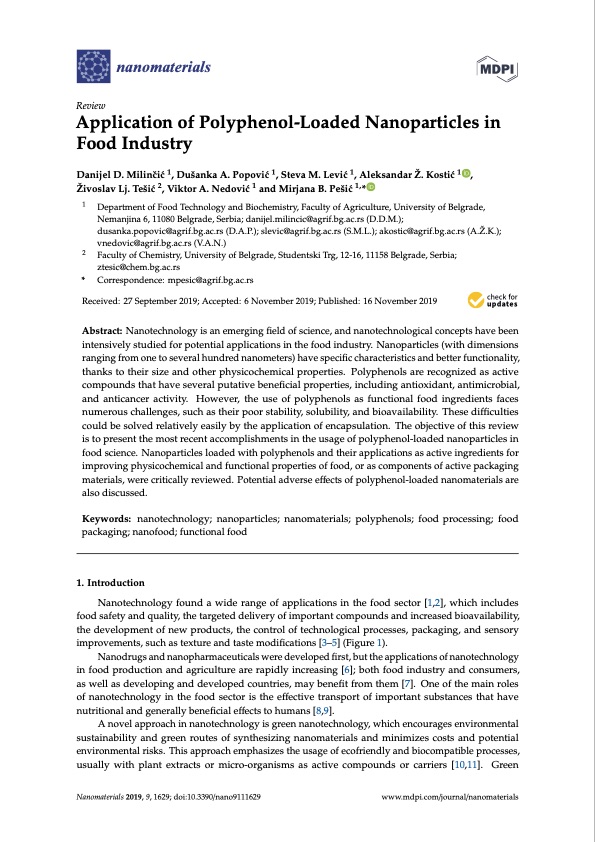
PDF Publication Title:
Text from PDF Page: 001
nanomaterials Review Application of Polyphenol-Loaded Nanoparticles in Food Industry Danijel D. Milincˇic ́ 1, Dušanka A. Popovic ́ 1, Steva M. Levic ́ 1, Aleksandar Ž. Kostic ́ 1 , Živoslav Lj. Tešic ́ 2, Viktor A. Nedovic ́ 1 and Mirjana B. Pešic ́ 1,* 1 Department of Food Technology and Biochemistry, Faculty of Agriculture, University of Belgrade, Nemanjina 6, 11080 Belgrade, Serbia; danijel.milincic@agrif.bg.ac.rs (D.D.M.); dusanka.popovic@agrif.bg.ac.rs (D.A.P.); slevic@agrif.bg.ac.rs (S.M.L.); akostic@agrif.bg.ac.rs (A.Ž.K.); vnedovic@agrif.bg.ac.rs (V.A.N.) 2 ztesic@chem.bg.ac.rs Faculty of Chemistry, University of Belgrade, Studentski Trg, 12-16, 11158 Belgrade, Serbia; * Correspondence: mpesic@agrif.bg.ac.rs Received: 27 September 2019; Accepted: 6 November 2019; Published: 16 November 2019 Abstract: Nanotechnology is an emerging field of science, and nanotechnological concepts have been intensively studied for potential applications in the food industry. Nanoparticles (with dimensions ranging from one to several hundred nanometers) have specific characteristics and better functionality, thanks to their size and other physicochemical properties. Polyphenols are recognized as active compounds that have several putative beneficial properties, including antioxidant, antimicrobial, and anticancer activity. However, the use of polyphenols as functional food ingredients faces numerous challenges, such as their poor stability, solubility, and bioavailability. These difficulties could be solved relatively easily by the application of encapsulation. The objective of this review is to present the most recent accomplishments in the usage of polyphenol-loaded nanoparticles in food science. Nanoparticles loaded with polyphenols and their applications as active ingredients for improving physicochemical and functional properties of food, or as components of active packaging materials, were critically reviewed. Potential adverse effects of polyphenol-loaded nanomaterials are also discussed. Keywords: nanotechnology; nanoparticles; nanomaterials; polyphenols; food processing; food packaging; nanofood; functional food 1. Introduction Nanotechnology found a wide range of applications in the food sector [1,2], which includes food safety and quality, the targeted delivery of important compounds and increased bioavailability, the development of new products, the control of technological processes, packaging, and sensory improvements, such as texture and taste modifications [3–5] (Figure 1). Nanodrugs and nanopharmaceuticals were developed first, but the applications of nanotechnology in food production and agriculture are rapidly increasing [6]; both food industry and consumers, as well as developing and developed countries, may benefit from them [7]. One of the main roles of nanotechnology in the food sector is the effective transport of important substances that have nutritional and generally beneficial effects to humans [8,9]. A novel approach in nanotechnology is green nanotechnology, which encourages environmental sustainability and green routes of synthesizing nanomaterials and minimizes costs and potential environmental risks. This approach emphasizes the usage of ecofriendly and biocompatible processes, usually with plant extracts or micro-organisms as active compounds or carriers [10,11]. Green Nanomaterials 2019, 9, 1629; doi:10.3390/nano9111629 www.mdpi.com/journal/nanomaterialsPDF Image | Polyphenol-Loaded Nanoparticles in Food Industry

PDF Search Title:
Polyphenol-Loaded Nanoparticles in Food IndustryOriginal File Name Searched:
nanomaterials-09-01629.pdfDIY PDF Search: Google It | Yahoo | Bing
Turbine and System Plans CAD CAM: Special for this month, any plans are $10,000 for complete Cad/Cam blueprints. License is for one build. Try before you buy a production license. More Info
Waste Heat Power Technology: Organic Rankine Cycle uses waste heat to make electricity, shaft horsepower and cooling. More Info
All Turbine and System Products: Infinity Turbine ORD systems, turbine generator sets, build plans and more to use your waste heat from 30C to 100C. More Info
CO2 Phase Change Demonstrator: CO2 goes supercritical at 30 C. This is a experimental platform which you can use to demonstrate phase change with low heat. Includes integration area for small CO2 turbine, static generator, and more. This can also be used for a GTL Gas to Liquids experimental platform. More Info
Introducing the Infinity Turbine Products Infinity Turbine develops and builds systems for making power from waste heat. It also is working on innovative strategies for storing, making, and deploying energy. More Info
Need Strategy? Use our Consulting and analyst services Infinity Turbine LLC is pleased to announce its consulting and analyst services. We have worked in the renewable energy industry as a researcher, developing sales and markets, along with may inventions and innovations. More Info
Made in USA with Global Energy Millennial Web Engine These pages were made with the Global Energy Web PDF Engine using Filemaker (Claris) software.
Infinity Turbine Developing Spinning Disc Reactor SDR or Spinning Disc Reactors reduce processing time for liquid production of Silver Nanoparticles.
| CONTACT TEL: 608-238-6001 Email: greg@infinityturbine.com | RSS | AMP |